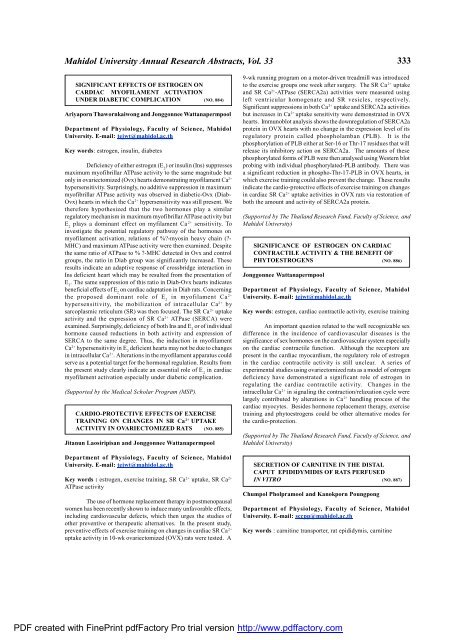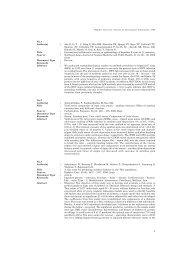Faculty of Science - Mahidol University
Faculty of Science - Mahidol University
Faculty of Science - Mahidol University
You also want an ePaper? Increase the reach of your titles
YUMPU automatically turns print PDFs into web optimized ePapers that Google loves.
<strong>Mahidol</strong> <strong>University</strong> Annual Research Abstracts, Vol. 33 333<br />
SIGNIFICANT EFFECTS OF ESTROGEN ON<br />
CARDIAC MYOFILAMENT ACTIVATION<br />
UNDER DIABETIC COMPLICATION (NO. 884)<br />
Ariyaporn Thawornkaiwong and Jonggonnee Wattanapermpool<br />
Department <strong>of</strong> Physiology, <strong>Faculty</strong> <strong>of</strong> <strong>Science</strong>, <strong>Mahidol</strong><br />
<strong>University</strong>. E-mail: tejwt@mahidol.ac.th<br />
Key words: estrogen, insulin, diabetes<br />
Deficiency <strong>of</strong> either estrogen (E 2 ) or insulin (Ins) suppresses<br />
maximum my<strong>of</strong>ibrillar ATPase activity to the same magnitude but<br />
only in ovariectomized (Ovx) hearts demonstrating my<strong>of</strong>ilament Ca 2+<br />
hypersensitivity. Surprisingly, no additive suppression in maximum<br />
my<strong>of</strong>ibrillar ATPase activity was observed in diabetic-Ovx (Diab-<br />
Ovx) hearts in which the Ca 2+ hypersensitivity was still present. We<br />
therefore hypothesized that the two hormones play a similar<br />
regulatory mechanism in maximum my<strong>of</strong>ibrillar ATPase activity but<br />
E 2 plays a dominant effect on myfilament Ca 2+ sensitivity. To<br />
investigate the potential regulatory pathway <strong>of</strong> the hormones on<br />
my<strong>of</strong>ilament activation, relations <strong>of</strong> %?-myosin heavy chain (?-<br />
MHC) and maximum ATPase activity were then examined. Despite<br />
the same ratio <strong>of</strong> ATPase to % ?-MHC detected in Ovx and control<br />
groups, the ratio in Diab group was significantly increased. These<br />
results indicate an adaptive response <strong>of</strong> crossbridge interaction in<br />
Ins deficient heart which may be resulted from the presentation <strong>of</strong><br />
E 2 . The same suppression <strong>of</strong> this ratio in Diab-Ovx hearts indicates<br />
beneficial effects <strong>of</strong> E 2 on cardiac adaptation in Diab rats. Concerning<br />
the proposed dominant role <strong>of</strong> E 2 in my<strong>of</strong>ilament Ca 2+<br />
hypersensitivity, the mobilization <strong>of</strong> intracellular Ca 2+ by<br />
sarcoplasmic reticulum (SR) was then focused. The SR Ca 2+ uptake<br />
activity and the expression <strong>of</strong> SR Ca 2+ ATPase (SERCA) were<br />
examined. Surprisingly, deficiency <strong>of</strong> both Ins and E 2 or <strong>of</strong> individual<br />
hormone caused reductions in both activity and expression <strong>of</strong><br />
SERCA to the same degree. Thus, the induction in my<strong>of</strong>ilament<br />
Ca 2+ hypersensitivity in E 2 deficient hearts may not be due to changes<br />
in intracellular Ca 2+ . Alterations in the my<strong>of</strong>ilament apparatus could<br />
serve as a potential target for the hormonal regulation. Results from<br />
the present study clearly indicate an essential role <strong>of</strong> E 2 in cardiac<br />
my<strong>of</strong>ilament activation especially under diabetic complication.<br />
(Supported by the Medical Scholar Program (MSP).<br />
CARDIO-PROTECTIVE EFFECTS OF EXERCISE<br />
TRAINING ON CHANGES IN SR Ca 2+ UPTAKE<br />
ACTIVITY IN OVARIECTOMIZED RATS (NO. 885)<br />
Jitanun Laosiripisan and Jonggonnee Wattanapermpool<br />
Department <strong>of</strong> Physiology, <strong>Faculty</strong> <strong>of</strong> <strong>Science</strong>, <strong>Mahidol</strong><br />
<strong>University</strong>. E-mail: tejwt@mahidol.ac.th<br />
Key words : estrogen, exercise training, SR Ca 2+ uptake, SR Ca 2+<br />
ATPase activity<br />
The use <strong>of</strong> hormone replacement therapy in postmenopausal<br />
women has been recently shown to induce many unfavorable effects,<br />
including cardiovascular defects, which then urges the studies <strong>of</strong><br />
other preventive or therapeutic alternatives. In the present study,<br />
preventive effects <strong>of</strong> exercise training on changes in cardiac SR Ca 2+<br />
uptake activity in 10-wk ovariectomized (OVX) rats were tested. A<br />
9-wk running program on a motor-driven treadmill was introduced<br />
to the exercise groups one week after surgery. The SR Ca 2+ uptake<br />
and SR Ca 2+ -ATPase (SERCA2a) activities were measured using<br />
left ventricular homogenate and SR vesicles, respectively.<br />
Significant suppressions in both Ca 2+ uptake and SERCA2a activities<br />
but increases in Ca 2+ uptake sensitivity were demonstrated in OVX<br />
hearts. Immunoblot analysis shows the downregulation <strong>of</strong> SERCA2a<br />
protein in OVX hearts with no change in the expression level <strong>of</strong> its<br />
regulatory protein called phospholamban (PLB). It is the<br />
phosphorylation <strong>of</strong> PLB either at Ser-16 or Thr-17 residues that will<br />
release its inhibitory action on SERCA2a. The amounts <strong>of</strong> these<br />
phosphorylated forms <strong>of</strong> PLB were then analysed using Western blot<br />
probing with individual phosphorylated-PLB antibody. There was<br />
a significant reduction in phospho-Thr-17-PLB in OVX hearts, in<br />
which exercise training could also prevent the change. These results<br />
indicate the cardio-protective effects <strong>of</strong> exercise training on changes<br />
in cardiac SR Ca 2+ uptake activities in OVX rats via restoration <strong>of</strong><br />
both the amount and activity <strong>of</strong> SERCA2a protein.<br />
(Supported by The Thailand Research Fund, <strong>Faculty</strong> <strong>of</strong> <strong>Science</strong>, and<br />
<strong>Mahidol</strong> <strong>University</strong>)<br />
SIGNIFICANCE OF ESTROGEN ON CARDIAC<br />
CONTRACTILE ACTIVITY & THE BENEFIT OF<br />
PHYTOESTROGENS (NO. 886)<br />
Jonggonnee Wattanapermpool<br />
Department <strong>of</strong> Physiology, <strong>Faculty</strong> <strong>of</strong> <strong>Science</strong>, <strong>Mahidol</strong><br />
<strong>University</strong>. E-mail: tejwt@mahidol.ac.th<br />
Key words: estrogen, cardiac contractile activity, exercise training<br />
An important question related to the well recognizable sex<br />
difference in the incidence <strong>of</strong> cardiovascular diseases is the<br />
significance <strong>of</strong> sex hormones on the cardiovascular system especially<br />
on the cardiac contractile function. Although the receptors are<br />
present in the cardiac myocardium, the regulatory role <strong>of</strong> estrogen<br />
in the cardiac contractile activity is still unclear. A series <strong>of</strong><br />
experimental studies using ovariectomized rats as a model <strong>of</strong> estrogen<br />
deficiency have demonstrated a significant role <strong>of</strong> estrogen in<br />
regulating the cardiac contractile activity. Changes in the<br />
intracellular Ca 2+ in signaling the contraction/relaxation cycle were<br />
largely contributed by alterations in Ca 2+ handling process <strong>of</strong> the<br />
cardiac myocytes. Besides hormone replacement therapy, exercise<br />
training and phytoestrogens could be other alternative modes for<br />
the cardio-protection.<br />
(Supported by The Thailand Research Fund, <strong>Faculty</strong> <strong>of</strong> <strong>Science</strong>, and<br />
<strong>Mahidol</strong> <strong>University</strong>)<br />
SECRETION OF CARNITINE IN THE DISTAL<br />
CAPUT EPIDIDYMIDIS OF RATS PERFUSED<br />
IN VITRO (NO. 887)<br />
Chumpol Pholpramool and Kanokporn Poungpong<br />
Department <strong>of</strong> Physiology, <strong>Faculty</strong> <strong>of</strong> <strong>Science</strong>, <strong>Mahidol</strong><br />
<strong>University</strong>. E-mail: sccpp@mahidol.ac.th<br />
Key words : carnitine transporter, rat epididymis, carnitine<br />
PDF created with FinePrint pdfFactory Pro trial version http://www.pdffactory.com

















